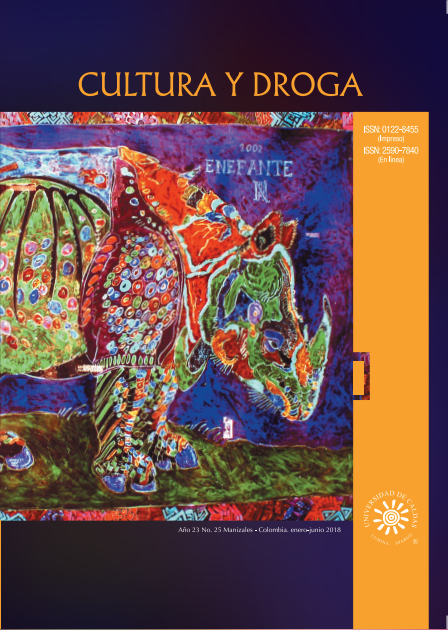Authors
Abstract
Objective and methodology. To present the results of two surveys contrasting the perceptions about stigma, the use of body symbols (tattoos), discriminatory attitudes and their effect on the quality of life and perceived opportunities of drug users (n = 100) and their families (n = 69) in the city of Tijuana, Mexico. Results. It was found that both discrimination and segregation extend from the users to their relatives. Tattoos are used as tribal symbols among users, while their use is disapproved by their relatives who report discrimination and segregation not only towards their family member but also to the rest of the family members. Conclusions. The relatives of users perceive more stigma than the users. More female than male users reported more self-segregation behaviors and social discrimination perceptions.
Keywords
References
Corrigan, P.W, Kuwabara, S.A. and O’Shaughnessy, J. (2009). The public stigma of mental illness and drug addiction: Findings from a stratified random sample. Journal of Social Work, 9, 139-147.
Corrigan, P.W. and Watson, A.C. (2002). The paradox of self-stigma and mental illness. Clinical Psychology: Science and Practice, 9, 35-53.
DeMello, M. (2000). Bodies of Inscription: A Cultural History of the Modern Tattoo Community. Durham, USA: Duke University Press.
Douglas, M. and Wildavsky, A. (1982). Risk and Culture. An Essay on the Selection of Technical and Environmental Dangers. Berkeley, USA: University of California Press.
Foster, G.S. and Hummel, R.L. (2000). The commodification of body modification: Tattoos and piercings from counterculture to campus. Chicago, USA: Midwest Sociological Society.
Goffman, E. (1961). Asylums: Essays on the Social Situation of Mental Patients and Other Inmates. New York, USA: Doubleday Anchor.
Goffman, E. (1963). Stigma: Notes on the Management of Spoiled Identity. New York, USA: Prentice-Hall.
González, R.P.J. (2006). La adicción a las drogas ilegales en el estado de Baja California ¿integración o rechazo social? (tesis de posgrado). Colegio de la Frontera Norte, Tijuana, México.
Link, B.G. et al. (1997). Study of Men with Dual Diagnoses of Mental Illness and Substance Abuse. Journal of Health and Social Behavior, 38, 177-190.
Martínez, M.L. (2009). Por discriminación laboral, los tatuados podrían interponer demandas. Recuperado de http://www.frecuencialaboral.com/tatuajes.html.
Nurutdinova, B.A. et al. (2006). HCV risk factors among street-recruited substanceabusing women. En College on Problems of Drug Dependence. Scottsdale, Arizona.
OPS. (2003). Una tendencia que crece, la extracción de tatuajes. Recuperado de http://www.ops.org.bo/servicios/?DB=B&S11=2216&SE=SN.
Pinel, E.C. (1999). Stigma consciousness: The psychological legacy of social stereotypes. Journal of Personality and Social Psychology, 76, 114-128.
Pitts, V. (2000). Visibly Queer: Body Technologies and Sexual Politics. The Sociological Quarterly, 41, 443-463.
Room, R. (2009). Stigma, social inequality and alcohol and drug use. Drug and Alcohol Review, 24 (2), 143-155.
Schomerus, G., Matschinger, H. and Angermeyer, M.C. (2006). Public beliefs about the causes of mental disorders revisited. Psychiatry Research, 144, 233-236.
Timming, A.R. (2015). Visible tattoos in the service sector: A new challenge to recruitment and selection. Work, Employment and Society, 29 (1), 60-78.
Valenzuela, J.M. (2009). El futuro ya fue. Socioantropología de l@s jóvenes en la modernidad. Tijuana, México: El Colegio de la Frontera Norte y Juan Pablos.

 PDF (Español)
PDF (Español)
 FLIP
FLIP





















